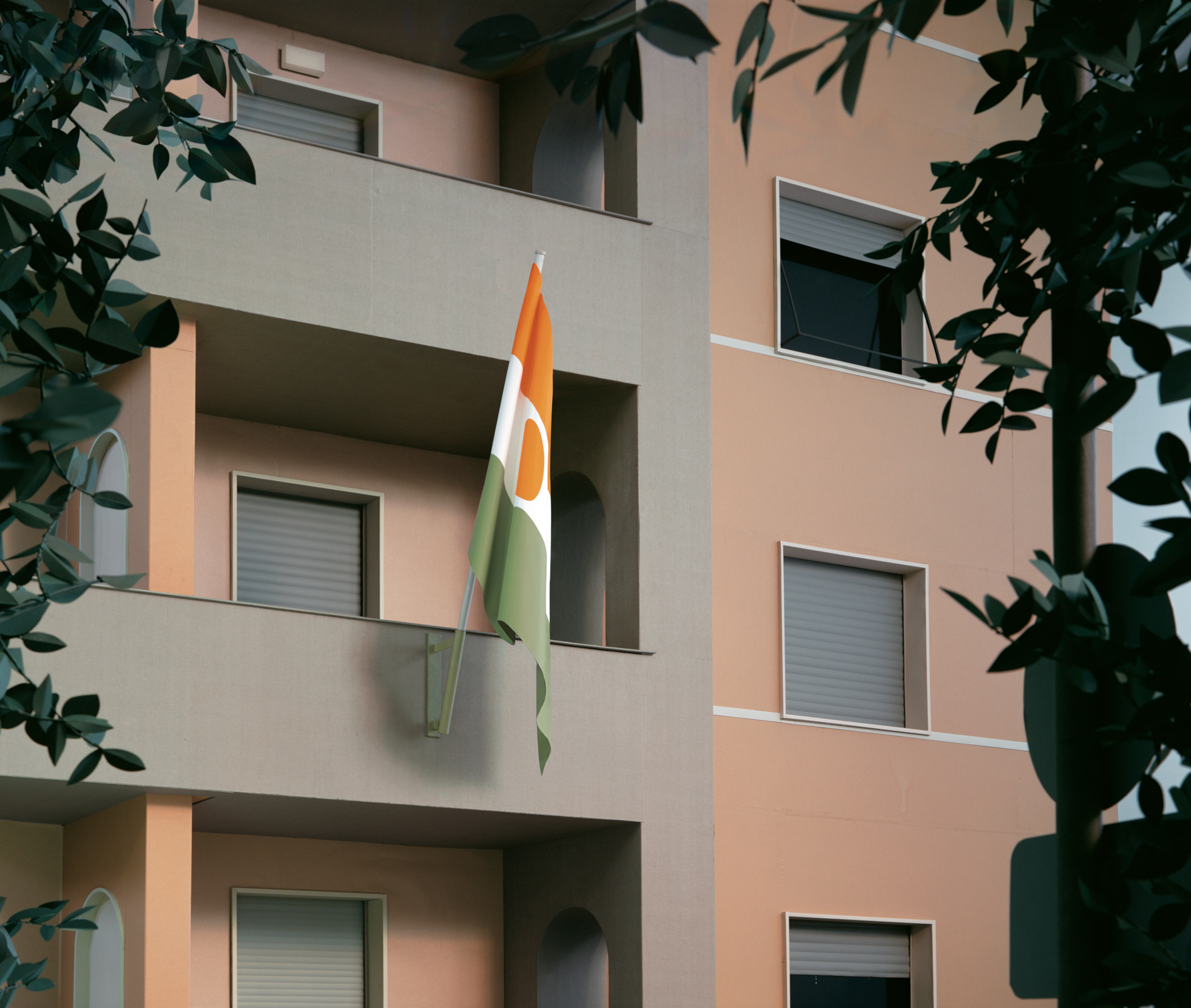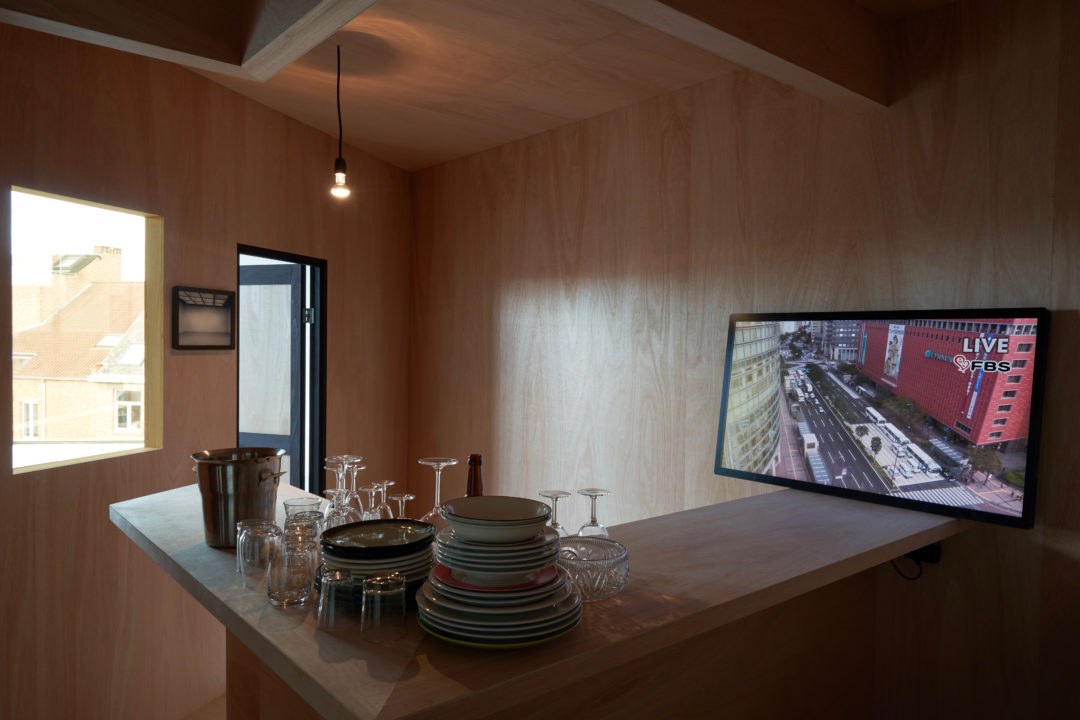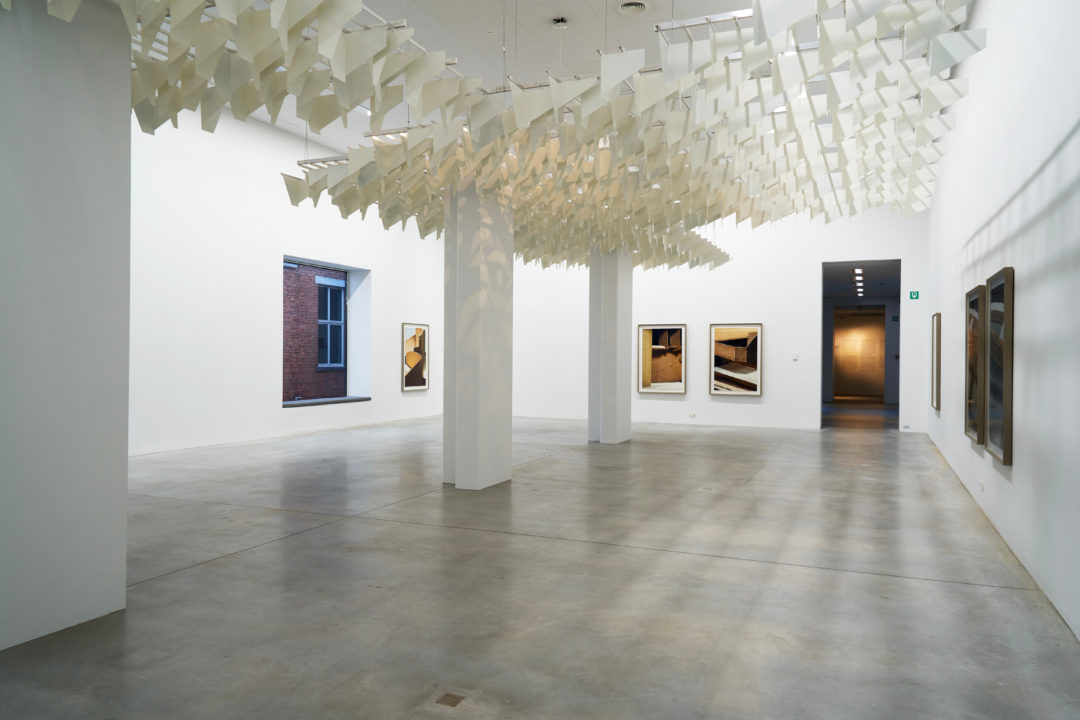Thomas Demand

House of card
M Museum, Leuven – 09.10.2020 – 18.04.2021
The M Museum in Leuven is currently presenting a solo show of Thomas Demand’s work. The Berlin-based artist is mainly known for his ability to reproduce reality and make models of it using paper and cardboard, which, once photographed, reach their final status of artworks. Mimicry and its re-definition lie at the heart of his practice, which consistently interrogates reality by rendering it fictional. In Leuven, the artist tackles matters which hit the headlines at their time, such as the case of the break-in and burglary of the embassy of Niger, which played a key role in the outbreak of the war in Iraq. The so-called theft of documents was used to prove Iraq’s determination to procure uranium ore —documents which, needless to say, have never been found. Following this absence, Saddam Hussein was held accountable… With Embassy, Demand acts like an investigator, as he overplays the falsification of reality by applying his own methodology to it. An architecture within the architecture, this labyrinthine work opens this exhibition with the evocative title of House of card, and leads to a succession of proposals which give room to collaborations—confirming, in passing, the artist’s interest in the discipline of architecture, from which he does not only draw inspiration, but rather reveals himself to be a gifted practitioner.

Having in mind the title of Jean Baudrillard’s famous book, the (second) Gulf war should have never really happened… if, among other mystifications, the fable of the disappearance of documents which compromised the Iraqi leader, and their staging had not been immediately endorsed and then heavily spread by American secret services. Without going back on the capacity of “democratic” governments to create false evidence in order to justify their belligerent operations, it is however interesting to wonder about the skills of the counterfeiter and the agility of simulacra-making people. These interrogations connect the thinking of the philosopher with that of the work of our artist. Because in the German artist’s activity are to be found challenges to the existence of reality, its tangible character, and its conditions of acceptability. With this all-encompassing work, which can be understood as a re-doubling of the museum space, we wonder where the artist wants to lead us to, and whether or not there might be a bit of duplicity in his approach. If so, what might be implied here is a tribute to those forgers and counterfeiters who have created, from scratch, a reality capable of toppling “the real” into tragedy: triggering a war, or decimating an entire population. Yet, at the same time, the work pushes us to question the power of the artist, who, for his part, is only capable of simulating reality by duplicating it. We can nevertheless focus on the most credible option; that of condemning leaders who are invariably inclined to manipulate people and ensure their compliance to a revengeful tropism.
In this rather politically-correct understanding of the work, Embassy calls into question the issue of a wide-spread intoxication of information to which our modern societies, suckling on “fake news”, are being more and more subjected to. But this might not be the most interesting phenomena, because the “real world” is also capable of reacting and responding with a generalized mistrust of “official” information—as again demonstrated by the vagaries of the US presidential elections and the outgoing president’s attempt to have people believe in fraudulent vote counting. Even the judges appointed by him have ended up disassociating themselves from this “official version”… Between the fiction-generating machine going back to the second Gulf war, the channelling of the American electorate by the Britannica Analytica company during Donald Trump’s election, and the concealment of the GAFAM1’s use of personal data, it is true that one might feel totally and utterly puzzled. In Passwords, Jean Baudrillard interrogates the advent of the virtual as a horizon of reality, to be understood as the overturn of the meaning of words, —since the virtual is meant to contain a reality yet to come.2 The philosopher concludes that going beyond reality (which, for him, does not exist anyway) is necessary. As such, might the re-creation of reality, as demonstrated by the German artist, and the remodelling of situations as if they were the cardboard set of our dramas, then constitute a new reversal, a caricatural and inoffensive re-edition of historical tragedy which—as we know since Marx—repeats itself in the form of farce?

Vue de la maquette dans l’exposition / View of the mock-up in the exhibition « House of card », M Museum, Louvain / Leuven.
In a conversation published in the catalogue of the exhibition between the philosopher Hal Foster, the architect David Chipperfield and the artist Thomas Demand, the issue of artists’ interest in architecture lies at the heart of the discussion. Chipperfield reminds us that twenty years ago, in the early days of his career, architects would draw inspiration from artists like Donald Judd and Hiroshi Sugimoto; whereas nowadays ways of looking have been reversed, making architecture a key interest for artists.3 For Thomas Demand, this shift could be explained by a comeback of social preoccupations within architecture, after years of excessive aestheticization and emphasis on surface rather than on “the living”. This social turning-point, to which many advocates of a new architecture lay claim, seems, paradoxically enough, to be a source of annoyance for the German artist. Indeed, he is critical of this conventional and overriding “right-thinking” imperative which, in fact, is tantamount to making an exhibition the illustration of a theme: “You have to be on the right side and your artwork has to prove that it is on the right side”4, he argues. In the never-ending quarrel pitting the supporters of an ethical art against those in favour of a formal or self-referential art, it would seem, at first glance, that Demand has chosen the arena of form.5 Only at first glance, because the artworks on view in Leuven are undeniably weighted by a very pronounced position of protest. Following the footsteps of Embassy, which can be read as a work against the “System”, Nagelhaus and Black Label both offer socially-conscious proposals where resistance to the sirens of a destructive urbanism takes form through the defence of modest and unassuming productions. The area beneath the Escher-Wyss-Platz viaduct, on the edge of Zurich’s swell neighbourhoods, was the object of a competition for its improvement, which was won by Demand, in association with Caruso St. John, much to the displeasure of the project’s opponents. The project itself consisted in an architecture favouring conviviality and encounter, as it was reacting to news coming from the other side of the planet: that involving a Chinese couple bracing themselves against the steamroller of urban development and stubbornly refusing to sell their restaurant, a modest building in the middle of a zone undergoing great pressure from property developers.

Vue d’installation dans l’exposition / Installation view in the exhibition « House of card »,
M Museum, Louvain / Leuven

Original UDC Party campaign poster, 2012. Courtesy SVP Stadt Zürich
In fact, Nagelhaus became the symbol of globalized resistance to gentrification, going against expected spectacular and photogenic architectural gestures. Although Demand and St. John won the competition and presented their project at the Venice Biennial, they had to deal with an extremely violent smear campaign, which finally ended the implementation of the project in the square in question: a sensitive space, on the borderline of the extension of the heart of the economic capital of the Swiss Confederation. The installation of such avant-garde projects, like that of artists’ studios, have often had the effect—and in spite of their advocates—of acting as the starting grounds for this same gentrification. Nagelhaus will only ever exist as a model, the way it exists at the museum in Leuven, and can do no more than make us question the capacity of artists, architects and poets to withstand the tidal wave of gentrification afflicting capital cities. Confronting the re-creation of the project on a 1:1 scale, which gives us an idea of what the Nagelhaus might have been if it had been completed, the artist exhibits the poster published by the opposing camp, thus demonstrating an undeniable capacity of resilience.
Black Label is part of the same, somewhat romantic movement against the tabula rasa which is in the process of becoming the norm in matters to do with urban development. A “wart” for some, who just see therein an anachronism slowing down the necessary modernization of the city, and a trove of conviviality and witness of a bygone period for others, the minute building housing the Black Label café has been miraculously spared by Tokyo planners. It now holds grounds in the midst of interweaving traffic routes, tram tracks and cycle lanes. As part of an invitation from the Kytakyushu CCA, the German artist had already shown his interest in this bar by exhibiting the photograph of a scale model made by him of this selfsame Black Label. In response to Demand’s work, Rirkrit Tiravanija had reconstructed, in that same CCA, the bar and all the elements contributing to its atmosphere, including a karaoke (Untitled 2013 (Thomas demands here), 2013). The Thai artist reproduced for the M Museum the installation that he had made some years earlier in the Tokyo art centre, and which is fully functional. That was without taking the health crisis into account; a crisis that has altered the Thai artist’s project since he would have operated the installation for as long as the show lasted. The project, which was considerably altered by this obstacle, is still a tribute to the “poetics of warts”.


Vue d’installation dans l’exposition / Installation view in the exhibition « House of card »,
M Museum, Louvain / Leuven.
Much of the show is devoted to the Model Studies series which Demand has been working on for years, and for which, unlike his usual practice of photographing his own models, the artist looks into the work of his contemporaries: fashion designers, sculptors and architects. An initial invitation was given to the Scottish artist Martin Boyce who is also greatly interested in architecture and city planning. His sculptures and installations thus juggle with the codes and aesthetics of street furniture and mainstream design, to which he then applies the criteria and values of a seemingly outmoded modernism. At the M Museum, his stylized metal tree may be regarded as questioning mimicry and the ins and outs of representation (Do Words Have Voices?, 2011). As such, the work deeply resonates with issues raised by Demand’s art.

Vue des installations dans l’exposition / Installation views in the exhibition « House of card », M Museum, Louvain / Leuven
The importance of the space dedicated to the work of Azzedine Alaïa and to his studio certainly finds its explanation in the central role of the model in Demand’s praxis—models which we may liken to “maquettes” in the field of architecture and “patterns” in the world of fashion design. If he exclusively pays tribute to Alaïa’s work, and not to any other fashion designer, it is because the work of the Franco-Tunisian designer —notoriously known for being indifferent to the seasonal nature of fashion—echoes questions raised by Demand, for whom the issue of completion is fundamental. Demand’s praxis has in fact been constantly hovering between these two poles of completion and non-completion, taking us back to the issue of a work’s temporality: when does the artist create a work? When does the architect create a work? When answering the question of knowing when the essential moment of creation is, David Chipperfield says that he does not “perform” when he delivers a project or when he inaugurates a building, but rather when he makes the first sketches, future preparatory drawings and contractual drawings which will progressively draw the project’s final form. It is this process, through these transitions and phases, these back-and-forths with his associates, that the architect’s “performance” exists.6 What is more, the analogy with the fashion designer’s work comes into full play through the example of someone like Alaïa, for whom studio work is the matrix of creation, in the midst of patterns and hundreds of re-usable motifs, forever re-used, re-arranged, improved, trimmed and infinitely drawn over. Here, he forms an open-ended database, a dynamic storage of motifs which will be usable by his “heirs”, like a disinterested gesture which recalls the idea of community, to which Demand seems extremely sensitive to.

Impression pigmentaire encadrée / Framed pigment print, 135 × 172 cm.
Copyright of the artist, VG Bild-Kunst, Bonn
There is no creation without community, no art without sharing the work required by art. In Demand’s case, these are not empty words. The M Museum show attests to the artist’s attachment to the sharing of ideas, works and, as one can imagine, desires: it is in fact rare to see an artist involve so many collaborations and invitations. As such, all the museum’s galleries present either collaborations with architects (Arnolf Brandlhuber, Caruso St. John, John Lautner), invitations made to artist friends (Martin Boyce, Rirkrit Tiravanija), or tributes (Azzedine Alaïa), as if the artist wanted to free himself once and for all from the position of the unique author, and fully advocate for the idea of a creative community.7
- See Soshana Zuboff, L’Âge du capitalisme de surveillance [The Age of Surveillance Capitalism], éditions Zulma, 2020.
- Jean Baudrillard, Mots de passe [Passwords], édition Pauvert, 2000, p. 46.
- Conversation between David Chipperfield, Hal Foster and Thomas Demand, House of Card exhibition catalogue, éditions Mack et M Museum, 2020, p. 158.
- “I think art is in danger of becoming a little bit of an illustration of a theme. You have to be on the right side and your artwork has to prove that it is on the right side”, op. cit., p. 172.
- “I think that’s partly why architecture is becoming interesting. Because it seems to be a field where form is taken seriously. It might also be a little of an escape route, I admit”, op. cit., p. 174.
- Op. cit., p.180.
- Hal Foster: “This is also true in art now—many artists are interested in the process as the work. And in the ways that process allows not only for more collaboration but also for more community. It’s almost as if the work becomes the experience, of the record, of the process”, op. cit., p. 180.
Pour toutes les vues d’exposition / For all exhibition views
Photos : Dirk Pauwels. Copyright of the artist, VG Bild-Kunst, Bonn.
Image on top : Thomas Demand, Embassy, 2007. Vue d’installation dans l’exposition / Installation view in the exhibition « House of card », M Museum, Louvain / Leuven
- From the issue: 95
- Share: ,
- By the same author: Lyon Biennial, Anozero' 24, Coimbra Biennal, Signs and Objects. Pop art from the Guggenheim Collection at Guggenheim Museum, Momentum 12 at Moss, Yayoi Kusama : 1945 to Now at Guggenheim Bilbao,
Related articles
GESTE Paris
by Gabriela Anco
On the High Line
by Warren Neidich
Lyon Biennial
by Patrice Joly

